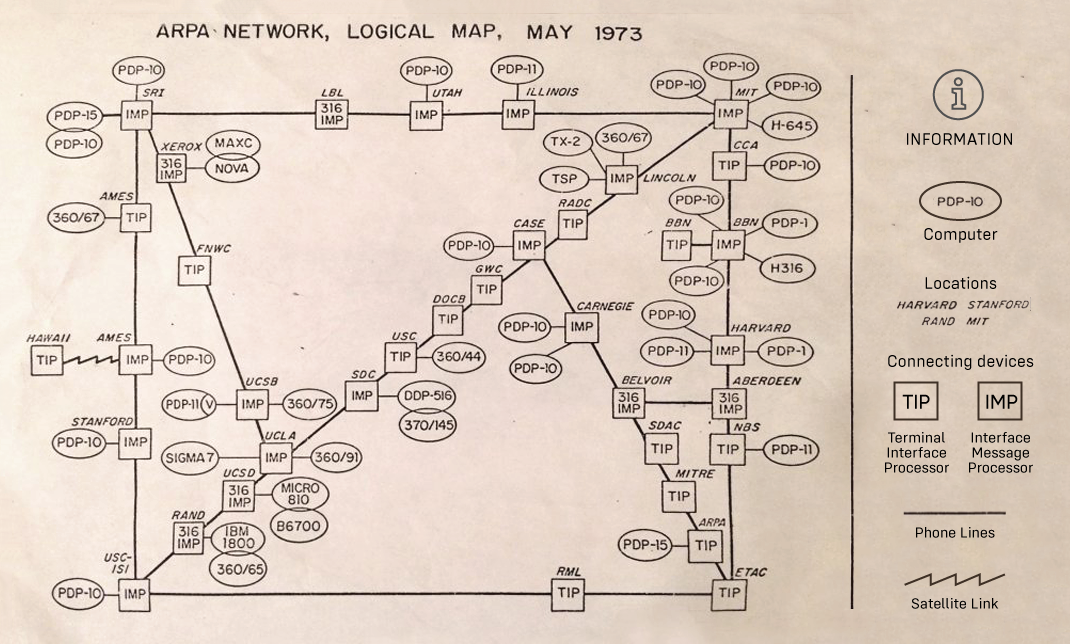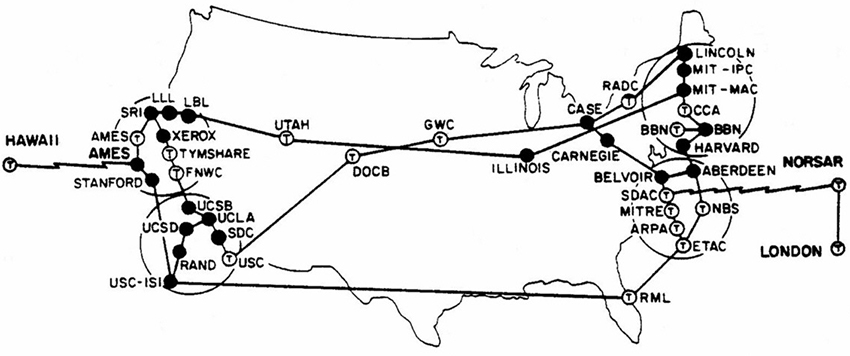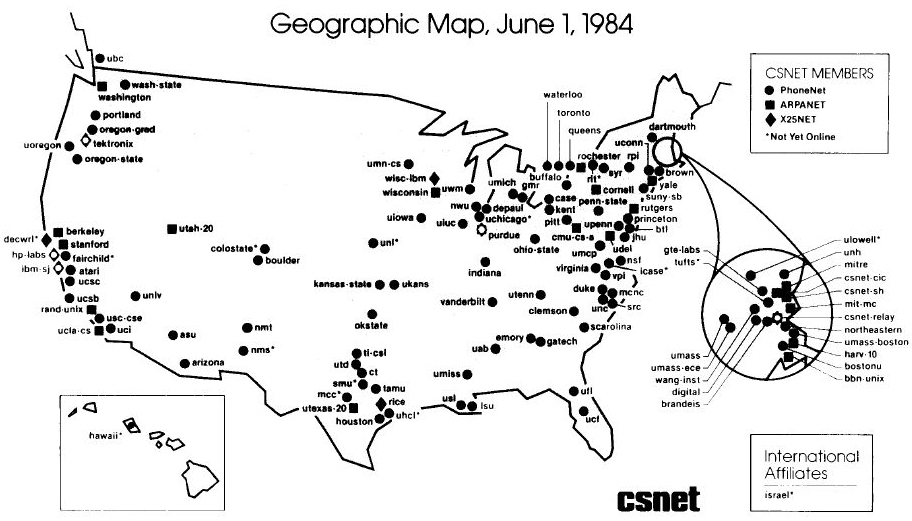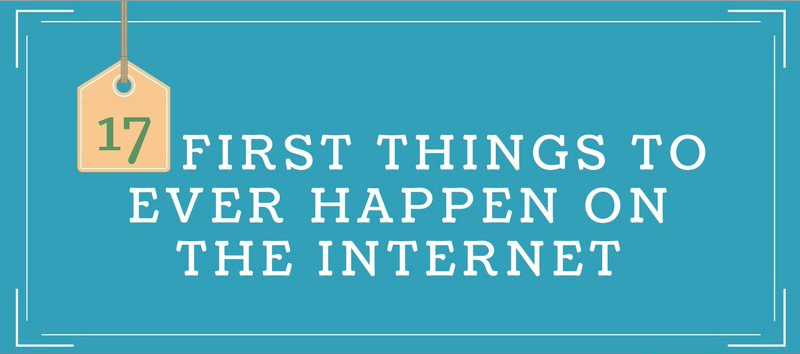Technology
This Paper Map Shows the Extent of the Entire Internet in 1973

This Map Shows the Extent of the Entire Internet in 1973
Before the modern internet, there was ARPANET.
ARPANET was the first internet-like network, and it was developed to allow multiple computers to share data across vast geographical distances. Interestingly, the researchers that worked on ARPANET are credited with developing many of the communication protocols that the internet still uses today.
Today’s map comes from David Newbury, who shared a keepsake from his father’s time as a computer science business manager at Carnegie Mellon University in the 1970s. We added a legend to help explain the symbols on the map.
A Brief History of ARPANET
ARPANET was funded in the late 1960s by a branch of the U.S. Military called The Advanced Research Projects Agency (ARPA), with the original purpose being to allow researchers at different universities to use their limited computing resources more efficiently.
Before ARPANET, if a researcher at Harvard wanted to access a database at Stanford, they had to travel there and use it in person. ARPANET was used to test out a new communication technology known as packet-switching, which broke up data into smaller “packets” and allowed various computers on the network to access the data.
With ARPANET researchers could:
- Login to another computer miles away
- Transfer and save files across the network
- Send emails from one person to several others
On the map above, you can see the network only had computers in the United States, but later that same year, a satellite link connected the ARPANET to Norway, creating the beginnings of a global network.

A Network of Networks
In 1983, ARPANET adopted the TCP/IP protocol standards which paved the way for a “network of networks”, and the internet was born. Several years later, ARPANET would be decommissioned and the new internet would begin to flourish.
Below you can see what the early internet looked like in 1984:

A Big Jump
These maps take us back to a simpler time when social networks, mobile phones, and unlimited access to the world’s information did not yet exist. Even 12 years after the first message was transmitted on the ARPANET, there were still only 213 computers on the network.
Fast forward a few decades later and the change in scale is mind-boggling – the modern internet has 1.94 billion websites and 4.1 billion internet users globally, resembling a digital universe.
One can only imagine how quaint the ARPANET will look a few more decades from now.
An earlier version of this article said the ARPANET was first connected internationally to the United Kingdom, but in fact, it was with Norway.
Technology
Visualizing AI Patents by Country
See which countries have been granted the most AI patents each year, from 2012 to 2022.

Visualizing AI Patents by Country
This was originally posted on our Voronoi app. Download the app for free on iOS or Android and discover incredible data-driven charts from a variety of trusted sources.
This infographic shows the number of AI-related patents granted each year from 2010 to 2022 (latest data available). These figures come from the Center for Security and Emerging Technology (CSET), accessed via Stanford University’s 2024 AI Index Report.
From this data, we can see that China first overtook the U.S. in 2013. Since then, the country has seen enormous growth in the number of AI patents granted each year.
| Year | China | EU and UK | U.S. | RoW | Global Total |
|---|---|---|---|---|---|
| 2010 | 307 | 137 | 984 | 571 | 1,999 |
| 2011 | 516 | 129 | 980 | 581 | 2,206 |
| 2012 | 926 | 112 | 950 | 660 | 2,648 |
| 2013 | 1,035 | 91 | 970 | 627 | 2,723 |
| 2014 | 1,278 | 97 | 1,078 | 667 | 3,120 |
| 2015 | 1,721 | 110 | 1,135 | 539 | 3,505 |
| 2016 | 1,621 | 128 | 1,298 | 714 | 3,761 |
| 2017 | 2,428 | 144 | 1,489 | 1,075 | 5,136 |
| 2018 | 4,741 | 155 | 1,674 | 1,574 | 8,144 |
| 2019 | 9,530 | 322 | 3,211 | 2,720 | 15,783 |
| 2020 | 13,071 | 406 | 5,441 | 4,455 | 23,373 |
| 2021 | 21,907 | 623 | 8,219 | 7,519 | 38,268 |
| 2022 | 35,315 | 1,173 | 12,077 | 13,699 | 62,264 |
In 2022, China was granted more patents than every other country combined.
While this suggests that the country is very active in researching the field of artificial intelligence, it doesn’t necessarily mean that China is the farthest in terms of capability.
Key Facts About AI Patents
According to CSET, AI patents relate to mathematical relationships and algorithms, which are considered abstract ideas under patent law. They can also have different meaning, depending on where they are filed.
In the U.S., AI patenting is concentrated amongst large companies including IBM, Microsoft, and Google. On the other hand, AI patenting in China is more distributed across government organizations, universities, and tech firms (e.g. Tencent).
In terms of focus area, China’s patents are typically related to computer vision, a field of AI that enables computers and systems to interpret visual data and inputs. Meanwhile America’s efforts are more evenly distributed across research fields.
Learn More About AI From Visual Capitalist
If you want to see more data visualizations on artificial intelligence, check out this graphic that shows which job departments will be impacted by AI the most.
-

 Mining1 week ago
Mining1 week agoGold vs. S&P 500: Which Has Grown More Over Five Years?
-

 Markets2 weeks ago
Markets2 weeks agoRanked: The Most Valuable Housing Markets in America
-

 Money2 weeks ago
Money2 weeks agoWhich States Have the Highest Minimum Wage in America?
-

 AI2 weeks ago
AI2 weeks agoRanked: Semiconductor Companies by Industry Revenue Share
-

 Markets2 weeks ago
Markets2 weeks agoRanked: The World’s Top Flight Routes, by Revenue
-

 Countries2 weeks ago
Countries2 weeks agoPopulation Projections: The World’s 6 Largest Countries in 2075
-

 Markets2 weeks ago
Markets2 weeks agoThe Top 10 States by Real GDP Growth in 2023
-

 Demographics2 weeks ago
Demographics2 weeks agoThe Smallest Gender Wage Gaps in OECD Countries


